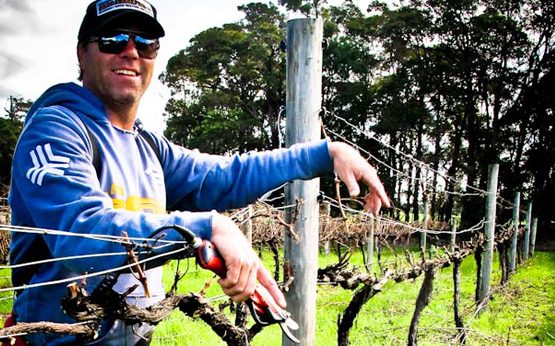Out in the Vineyard
Contributed by Bruce Pearse, Viticulturist
The process of flowering is complex and is influenced by many factors. For instance, the start of flowering on a bunch is signified by the release of the protecting cap, which are in fact the flower petals. This process is technically called anthesis but we just simply call it cap-fall. When the inflorescence are matured, cap-fall will usually occur mid morning, and is triggered by changes in the turgor of the interlocking cells that secured the cap. As the temperature raises the petals become free of their bases; they can separate along the margins and curve upwards to release the stamens. The flowers contain both male and female functional parts and can be self fertilised without the aid of insects or wind.
From what I have observed over the last few weeks through flowering and fruit set, the potential for fruitfulness and yield at this early stage of fruit development looks to be very promising. The talk of oversupply and poor sales of fruit continues but we need to consider that there is still demand for high quality fruit and wine sales are still being made and we are finding better ways to market wine and different overseas markets that are finding a taste for Margaret River wines. For this reason it is so important that viticulturists use whatever means possible to increase the quality of fruit. At this late stage of the production cycle, this can include the use of foliar fertilizers to help balance the vine canopy health with the potential crop load.
We understand the importance of having the right attributes in soils to help supply the balance of nutrients, minerals and moisture for the grapevine. The soil structure and mineral balance in the soil can affect the vine roots ability to take up the required elements from the soil and we need to assess the health of the vine to understand any limitations to vine performance. We do undertake the sampling of leaves and petioles (the petiole is the connecting part between the leaf and the grape vine shoot) so that analysis of the mineral capacity within the plant can be assessed. To do this, we wait until pre-flowering and select the fifth mature leaf and petiole down from the growing tip of the new shoot. These leaves and petioles are usually alongside the newly forming bunch and we remove a sample of leaves and petioles from a selection of vines across the block to form a representative sample. The leaves and petioles are sent to the laboratory and a test is performed to determine the level of minerals. We enter the results into a graph model which has predetermined levels for satisfactory vine performance for the corresponding growth stage and grape variety and then we print out a graph that allows easy consideration for recommendations. I do like to visit the vineyard and inspect the vines performance and also to look for mineral deficiency symptoms on the vine leaves. This visual inspection certainly supports what we see in the graph results but we also need to assess the vines growth and general appearance before making recommendations. This is particularly important where nitrogen may show in low values in the leaf and petiole results but the vines appear healthy and vigorous, at this point we would opt for a conservative approach and not add nitrogen to the vines. The issue with high vigor but low nitrogen status in leaves may be best explained that within the vine, the use of nitrogen (and other mineral elements) will be depleted during periods of strong growth or fruit formation, we would naturally see a reduction in measured saturation levels in the leaves and petioles but the health and vigor of the vines would be indicative of vine performance and the need (or not) to apply additional nutrients. Of course, if we do need a little help to improve the vine health at this late stage, we can use a foliar fertilizer or plant conditioner that is applied to the vine canopy through the spray cart (kelp and fish derived emulsions are good examples of plant conditioners).
We encourage the viticulturist to be out amongst the vines; touching, feeling and observing the performance and health of the vineyard. This is where we make the biggest difference to wine quality.
These viticultural guys and girls are in close contact with the winemaker, out in the vineyard every day looking at vine performance, monitoring for pests and disease and when necessary shoot thinning, removing leaf, strategically bunch thinning and tending the vines within a perfect environment to allow the very best in wine quality. This is what makes growing grapes so much more satisfying and achievable in the Margaret River wine region.
About Margaret River Discovery Tours
Sean Blocksidge is the owner operator of the Margaret River Discovery Company, an avid photographer, blogger and South West WA ambassador. In 2010 he won Western Australian Guide of the Year and his tours have been rated the #1 thing to do in Australia on the Tripadvisor website for the past two years.



